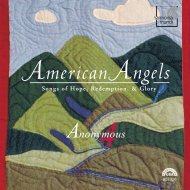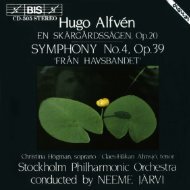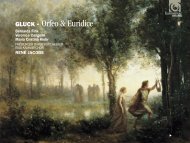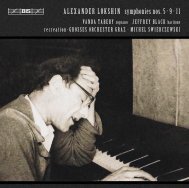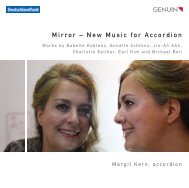Album booklet - eClassical
Album booklet - eClassical
Album booklet - eClassical
Create successful ePaper yourself
Turn your PDF publications into a flip-book with our unique Google optimized e-Paper software.
down an octave when rewriting it for the organ, and<br />
it has generally been thought that the organ part<br />
should be played an octave higher throughout, in<br />
other words in the four-foot register rather than the<br />
eight-foot register. This assumption is partly based<br />
on the frequent ap pear ance of parallel fifths and<br />
octaves between the solo part as notated and the<br />
parts for strings and winds, for instance in bars 66<br />
and 74 of the first movement. There are also pas -<br />
sages in the second movement where the solo part,<br />
if played in the lower octave, would end up at a<br />
lower pitch than the continuo.<br />
To perform the whole of this magnificent organ<br />
part without using the eight-foot register seems mis -<br />
taken to me, however, as this would severely limit<br />
the registrational possibilities of fered by the organ.<br />
It would furthermore be diffi cult for the organ to pit<br />
itself against the large-scale instru men ta tion (in -<br />
cluding three oboes) that was probably not a feature<br />
of the original violin concerto. Moreover, the range<br />
employed in the second movement is ab normally<br />
low for a per formance using only the four-foot reg -<br />
ister. As a result it would be difficult for the organ to<br />
stand on an equal footing with a four-part choir, no<br />
mat ter how small the forces in volved.<br />
It is true that if the eight-foot register is used,<br />
the organ part – as notated by Bach – will sound an<br />
octave lower than the violin part of the orig inal<br />
con certo. But this would merely be the equi valent<br />
of playing the original part using sixteen-foot stops<br />
– a common practice which sounds en tirely natural<br />
on the organ.<br />
BWV 146/3<br />
As regards the third movement, it is debatable whe -<br />
ther the obbligato part should be performed on the<br />
9<br />
organ or on the violin. Docu mentary evidence seems<br />
to suggest the organ, but it is quite possible that the<br />
original part might have been given to the violin. In<br />
this movement the range covered by the obbligato<br />
part fits easily with in the ranges of both instruments<br />
and it is there fore not possible to determine which<br />
instru ment would have been used on the basis of<br />
the pitch range alone. For this performance we have<br />
decided to use the organ because of the docu -<br />
mentary evidence and because the figurations in the<br />
part seem to be better suited to a keyboard in stru -<br />
ment than to a stringed instrument.<br />
© Masaaki Suzuki 2009<br />
The Bach Collegium Japan was founded in 1990<br />
by Masaaki Suzuki, who remains its music director,<br />
with the aim of introducing Japanese audi ences to<br />
period instrument performances of great works<br />
from the baroque period. The BCJ comprises both<br />
orchestra and chorus, and its major activities in -<br />
clude an annual concert series of J. S. Bach’s can -<br />
tatas and a number of instru mental programmes.<br />
Since 1995 the BCJ has ac quired a formidable rep -<br />
uta tion through its rec ordings of Bach’s church can -<br />
tatas. In 2000, the 250th anniversary year of Bach’s<br />
death, the BCJ extended its activities to the inter -<br />
national music scene with appearances at major fes -<br />
tivals in cities such as Santiago de Compostela, Tel<br />
Aviv, Leip zig and Melbourne. A highly success ful<br />
North American tour in 2003, including a con cert at<br />
Car negie Hall in New York, has been fol lowed by<br />
appearances at the Ansbach Bach woche and<br />
Schles wig-Holstein Music Festival in Germany as<br />
well as at the BBC Proms in London, and in the








